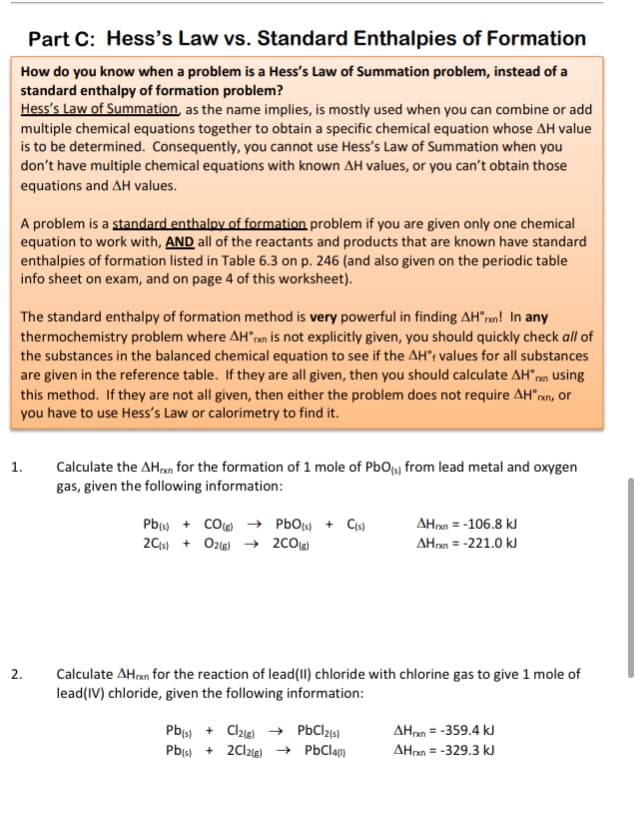Calculate the AHn for the formation of 1 mole of PbOs) from lead metal and oxygen gas, given the following information: 1. AHran =-106.8 kJ Pb() + COle → PbOs) + C) 2G) + Ozie) → 2C0 AHan = -221.0 kJ 2. Calculate AHan for the reaction of lead(I1) chloride with chlorine gas to give 1 mole of lead(IV) chloride, given the following information: Pb + Pbis) PbClz) 2Clzie) → PbClam AHan = -359.4 kJ AHan = -329.3 kJ
Calculate the AHn for the formation of 1 mole of PbOs) from lead metal and oxygen gas, given the following information: 1. AHran =-106.8 kJ Pb() + COle → PbOs) + C) 2G) + Ozie) → 2C0 AHan = -221.0 kJ 2. Calculate AHan for the reaction of lead(I1) chloride with chlorine gas to give 1 mole of lead(IV) chloride, given the following information: Pb + Pbis) PbClz) 2Clzie) → PbClam AHan = -359.4 kJ AHan = -329.3 kJ
Chemistry by OpenStax (2015-05-04)
1st Edition
ISBN:9781938168390
Author:Klaus Theopold, Richard H Langley, Paul Flowers, William R. Robinson, Mark Blaser
Publisher:Klaus Theopold, Richard H Langley, Paul Flowers, William R. Robinson, Mark Blaser
Chapter5: Thermochemistry
Section: Chapter Questions
Problem 80E: Ethanol, C2H5OH, is used as a fuel for motor vehicles, particularly in Brazil. (a) Write the...
Related questions
Question
Please help me

Transcribed Image Text:Part C: Hess's Law vs. Standard Enthalpies of Formation
How do you know when a problem is a Hess's Law of Summation problem, instead of a
standard enthalpy of formation problem?
Hess's Law of Summation, as the name implies, is mostly used when you can combine or add
multiple chemical equations together to obtain a specific chemical equation whose AH value
is to be determined. Consequently, you cannot use Hess's Law of Summation when you
don't have multiple chemical equations with known AH values, or you can't obtain those
equations and AH values.
A problem is a standard enthalpy of formation problem if you are given only one chemical
equation to work with, AND all of the reactants and products that are known have standard
enthalpies of formation listed in Table 6.3 on p. 246 (and also given on the periodic table
info sheet on exam, and on page 4 of this worksheet).
The standard enthalpy of formation method is very powerful in finding AH°ran! In any
thermochemistry problem where AH"ran is not explicitly given, you should quickly check all of
the substances in the balanced chemical equation to see if the AH°; values for all substances
are given in the reference table. If they are all given, then you should calculate AH"rn using
this method. If they are not all given, then either the problem does not require AH°rxn, or
you have to use Hess's Law or calorimetry to find it.
Calculate the AHn for the formation of 1 mole of PbOfs) from lead metal and oxygen
gas, given the following information:
1.
Pb + CO → PbOts) + Cs)
2Cs) + Oze) → 2C0
AHnn = -106.8 kJ
AHan = -221.0 kJ
Calculate AHxn for the reaction of lead(II) chloride with chlorine gas to give 1 mole of
lead(IV) chloride, given the following information:
2.
Pbs) + Clzie) → PbClzs)
Pb(s) + 2Cl2ie) → PbCla)
AHan = -359.4 kJ
AHn = -329.3 kJ
Expert Solution
This question has been solved!
Explore an expertly crafted, step-by-step solution for a thorough understanding of key concepts.
This is a popular solution!
Trending now
This is a popular solution!
Step by step
Solved in 3 steps with 3 images

Knowledge Booster
Learn more about
Need a deep-dive on the concept behind this application? Look no further. Learn more about this topic, chemistry and related others by exploring similar questions and additional content below.Recommended textbooks for you

Chemistry by OpenStax (2015-05-04)
Chemistry
ISBN:
9781938168390
Author:
Klaus Theopold, Richard H Langley, Paul Flowers, William R. Robinson, Mark Blaser
Publisher:
OpenStax

Living By Chemistry: First Edition Textbook
Chemistry
ISBN:
9781559539418
Author:
Angelica Stacy
Publisher:
MAC HIGHER

Chemistry: The Molecular Science
Chemistry
ISBN:
9781285199047
Author:
John W. Moore, Conrad L. Stanitski
Publisher:
Cengage Learning

Chemistry by OpenStax (2015-05-04)
Chemistry
ISBN:
9781938168390
Author:
Klaus Theopold, Richard H Langley, Paul Flowers, William R. Robinson, Mark Blaser
Publisher:
OpenStax

Living By Chemistry: First Edition Textbook
Chemistry
ISBN:
9781559539418
Author:
Angelica Stacy
Publisher:
MAC HIGHER

Chemistry: The Molecular Science
Chemistry
ISBN:
9781285199047
Author:
John W. Moore, Conrad L. Stanitski
Publisher:
Cengage Learning

Chemistry: Principles and Practice
Chemistry
ISBN:
9780534420123
Author:
Daniel L. Reger, Scott R. Goode, David W. Ball, Edward Mercer
Publisher:
Cengage Learning

Chemistry for Engineering Students
Chemistry
ISBN:
9781337398909
Author:
Lawrence S. Brown, Tom Holme
Publisher:
Cengage Learning

Chemistry: An Atoms First Approach
Chemistry
ISBN:
9781305079243
Author:
Steven S. Zumdahl, Susan A. Zumdahl
Publisher:
Cengage Learning